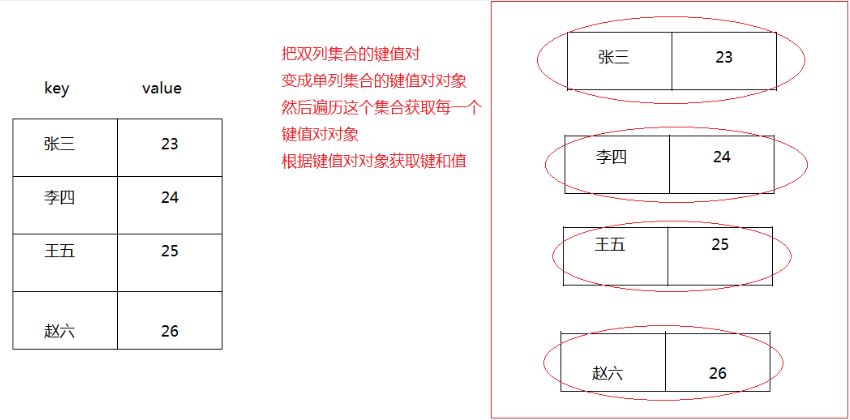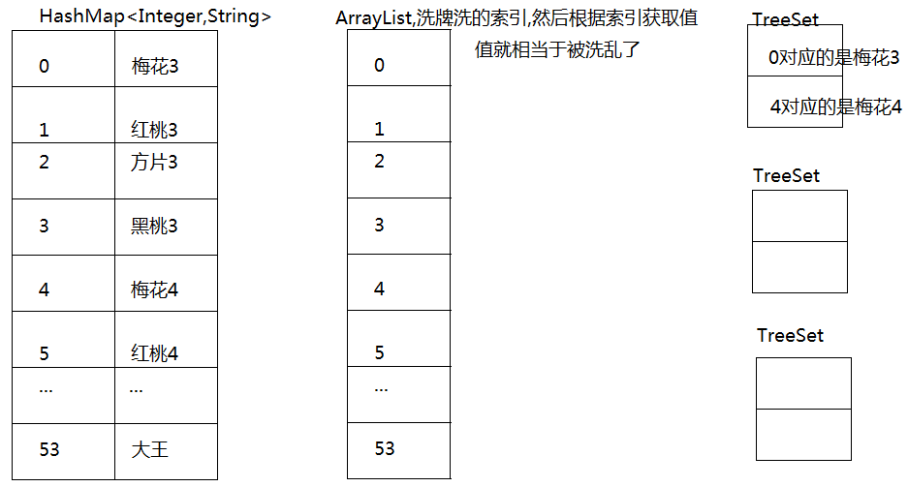集合框架(Map集合概述和特点)
集合框架(Map集合的功能概述)
集合框架(Map集合的遍历之键找值)
集合框架(Map集合的遍历之键值对对象找键和值)
集合框架(Map集合的遍历之键值对对象找键和值源码分析)
集合框架(HashMap集合键是Student值是String的案例)
集合框架(LinkedHashMap的概述和使用)
集合框架(TreeMap集合键是Student值是String的案例)
集合框架(统计字符串中每个字符出现的次数)
集合框架(集合嵌套之HashMap嵌套HashMap)
集合框架(HashMap和Hashtable的区别)
集合框架(Collections工具类的概述和常见方法讲解)
集合框架(模拟斗地主洗牌和发牌)
集合框架(模拟斗地主洗牌和发牌并对牌进行排序的原理图解)
集合框架(模拟斗地主洗牌和发牌并对牌进行排序的代码实现)
集合框架(泛型固定下边界)
###18.01_集合框架(Map集合概述和特点)
A:Map接口概述
查看API可以知道:
将键映射到值的对象
一个映射不能包含重复的键
每个键最多只能映射到一个值
B:Map接口和Collection接口的不同
Map是双列的,Collection是单列的
Map的键唯一,Collection的子体系Set是唯一的
Map集合的数据结构值针对键有效,跟值无关;Collection集合的数据结构是针对元素有效
###18.02_集合框架(Map集合的功能概述)
A:Map集合的功能概述
a:添加功能
V put(K key,V value):添加元素。
如果键是第一次存储,就直接存储元素,返回null
如果键不是第一次存在,就用值把以前的值替换掉,返回以前的值
Map<String, Integer> map = new HashMap<String, Integer>(); Integer i1 = map.put("张三", 23); Integer i2= map.put("李四", 24); Integer i3 = map.put("王五", 25); Integer i4 = map.put("赵六", 26); Integer i5 = map.put("张三", 26); //相同的键不存储,值覆盖,把被覆盖的值返回
System.out.println(map); //{赵六=26, 张三=26, 李四=24, 王五=25}
System.out.println(i1); //null System.out.println(i2); //null System.out.println(i3); //null System.out.println(i4); //null System.out.println(i5); //23 |
b:删除功能
void clear():移除所有的键值对元素
V remove(Object key):根据键删除键值对元素,并把值返回
c:判断功能
boolean containsKey(Object key):判断集合是否包含指定的键
boolean containsValue(Object value):判断集合是否包含指定的值
boolean isEmpty():判断集合是否为空
Map<String, Integer> map = new HashMap<String, Integer>(); map.put("张三", 23); map.put("李四", 24); map.put("王五", 25); map.put("赵六", 26);
//Integer value = map.remove("张三"); //根据键删除元素,返回键对应的值 //System.out.println(value); //23 System.out.println(map.containsKey("张三")); //判断是否包含传入的键 System.out.println(map.containsValue(100)); //判断是否包含传入的值 System.out.println(map); |
d:获取功能
Set<Map.Entry<K,V>> entrySet():
V get(Object key):根据键获取值
Set<K> keySet():获取集合中所有键的集合
Collection<V> values():获取集合中所有值的集合
e:长度功能
int size():返回集合中的键值对的个数
Map<String, Integer> map = new HashMap<String, Integer>(); map.put("张三", 23); map.put("李四", 24); map.put("王五", 25); map.put("赵六", 26);
Collection<Integer> c = map.values(); System.out.println(c); //[26, 23, 24, 25] System.out.println(map.size()); //4 |
###18.03_集合框架(Map集合的遍历之键找值)
通过查看Map集合的api发现没有iterator方法,那么双列集合如何迭代呢?
根据键获取值
A:键找值思路:
获取所有键的集合
遍历键的集合,获取到每一个键
根据键找值
B:案例演示
Map集合的遍历之键找值
Map<String, Integer> map = new HashMap<String, Integer>(); map.put("张三", 23); map.put("李四", 24); map.put("王五", 25); map.put("赵六", 26);
//Integer i = map.get("张三"); //根据键获取值 //System.out.println(i); //23
//获取所有的键, 迭代器遍历 /*Set<String> keySet = map.keySet(); //获取集合中所有键的集合 Iterator<String> it = keySet.iterator(); //获取迭代器 while(it.hasNext()) { //判断单列集合中是否有元素 String key = it.next();//获取集合中的每一个键(元素),其实就是双列集合中的键 Integer value = map.get(key); //根据键获取值 System.out.println(key + "=" + value); //打印键值对 }*/
//使用增强for循环遍历 for(String key : map.keySet()) { //map.keySet()是所有键的集合 System.out.println(key + "=" + map.get(key)); } } |

###18.04_集合框架(Map集合的遍历之键值对对象找键和值)
A:键值对对象找键和值思路:
获取所有键值对对象的集合
遍历键值对对象的集合,获取到每一个键值对对象
根据键值对对象找键和值
B:案例演示
Map集合的遍历之键值对对象找键和值
Map<String, Integer> map = new HashMap<String, Integer>(); map.put("张三", 23); map.put("李四", 24); map.put("王五", 25); map.put("赵六", 26);
//Map.Entry说明Entry是Map的内部接口,将键和值封装成了Entry对象,并存储在Set集合中 /*Set<Map.Entry<String, Integer>> entrySet = map.entrySet(); //获取每一个对象 Iterator<Map.Entry<String, Integer>> it = entrySet.iterator(); while(it.hasNext()) { //获取每一个Entry对象 Map.Entry<String, Integer> en = it.next(); //父类引用指向子类对象 //Entry<String, Integer> en = it.next(); //直接获取的是子类对象 String key = en.getKey(); //根据键值对对象获取键 Integer value = en.getValue(); //根据键值对对象获取值 System.out.println(key + "=" + value); }*/
for(Entry<String, Integer> en : map.entrySet()) { System.out.println(en.getKey() + "=" + en.getValue()); } |

C:源码分析
HashMap----Entry
###18.05_集合框架(HashMap集合键是Student值是String的案例)
A:案例演示
HashMap集合键是Student值是String的案例
HashMap<Student, String> hm = new HashMap<Student, String>();//保证元素唯一,需要重写hashCode,equals方法 hm.put(new Student("张三", 23), "北京"); hm.put(new Student("张三", 23), "上海"); hm.put(new Student("李四", 24), "广州"); hm.put(new Student("王五", 25), "深圳");
System.out.println(hm);//{Student [name=张三, age=23]=上海, Student [name=李四, age=24]=广州, Student [name=王五, age=25]=深圳} |
###18.06_集合框架(LinkedHashMap的概述和使用)
A:案例演示
LinkedHashMap的特点
底层是链表实现的可以保证怎么存就怎么取
LinkedHashMap<String, Integer> lhm = new LinkedHashMap<String, Integer>(); lhm.put("张三", 23); lhm.put("李四", 24); lhm.put("赵六", 26); lhm.put("王五", 25);
System.out.println(lhm); //{张三=23, 李四=24, 赵六=26, 王五=25} |
###18.07_集合框架(TreeMap集合键是Student值是String的案例)
A:案例演示
TreeMap集合键是Student值是String的案例
public class Student implements Comparable<Student> { |
重写compareTo方法
@Override public int compareTo(Student o) { int num = this.age - o.age; //以年龄为主要条件 return num == 0 ? this.name.compareTo(o.name) : num; } |
TreeMap<Student, String> tm = new TreeMap<Student, String>(); tm.put(new Student("张三", 23), "北京"); tm.put(new Student("李四", 13), "上海"); tm.put(new Student("王五", 33), "广州"); tm.put(new Student("赵六", 43), "深圳");
System.out.println(tm);//{Student [name=李四, age=13]=上海, Student [name=张三, age=23]=北京, Student [name=王五, age=33]=广州, Student [name=赵六, age=43]=深圳} |

TreeMap<Student, String> tm = new TreeMap<Student, String>(new Comparator<Student>() { @Override public int compare(Student s1, Student s2) { int num = s1.getName().compareTo(s2.getName()); //按照姓名比较 return num == 0 ? s1.getAge() - s2.getAge() : num; } }); tm.put(new Student("张三", 23), "北京"); tm.put(new Student("李四", 13), "上海"); tm.put(new Student("赵六", 43), "深圳"); tm.put(new Student("王五", 33), "广州");
System.out.println(tm);//{Student [name=张三, age=23]=北京, Student [name=李四, age=13]=上海, Student [name=王五, age=33]=广州, Student [name=赵六, age=43]=深圳} |
###18.08_集合框架(统计字符串中每个字符出现的次数)
A:案例演示
需求:统计字符串中每个字符出现的次数
//1,定义一个需要被统计字符的字符串 String s = "aaaabbbbbccccccccccccc"; //2,将字符串转换为字符数组 char[] arr = s.toCharArray(); //3,定义双列集合,存储字符串中字符以及字符出现的次数 HashMap<Character, Integer> hm = new HashMap<Character, Integer>(); //4,遍历字符数组获取每一个字符,并将字符存储在双列集合中 for(char c: arr) { //5,存储过程中要做判断,如果集合中不包含这个键,就将该字符当作键,值为1存储,如果集合中包含这个键,就将值加1存储 /*if(!hm.containsKey(c)) { //如果不包含这个键 hm.put(c, 1); //就将键和值为1添加 }else { //如果包含这个键 hm.put(c, hm.get(c) + 1); //就将键和值再加1添加进来 }*/ hm.put(c, !hm.containsKey(c) ? 1 : hm.get(c) + 1); } //6,打印双列集合获取字符出现的次数
for (Character key : hm.keySet()) { //hm.keySet()代表所有键的集合 System.out.print(key + "=" + hm.get(key) + " ");//b=5 c=13 a=4 //hm.get(key)根据键获取值 } |
###18.09_集合框架(集合嵌套之HashMap嵌套HashMap)
A:案例演示
集合嵌套之HashMap嵌套HashMap
需求:
* 双元课堂有很多基础班
* 第88期基础班定义成一个双列集合,键是学生对象,值是学生的归属地
* 第99期基础班定义成一个双列集合,键是学生对象,值是学生的归属地
*
* 无论88期还是99期都是班级对象,所以为了便于统一管理,把这些班级对象添加到双元课堂集合中
//定义88期基础班 HashMap<Student, String> hm88 = new HashMap<Student, String>(); hm88.put(new Student("张三", 23), "北京"); hm88.put(new Student("李四", 24), "北京"); hm88.put(new Student("王五", 25), "上海"); hm88.put(new Student("赵六", 26), "广州");
//定义99期基础班 HashMap<Student, String> hm99 = new HashMap<Student, String>(); hm99.put(new Student("唐僧", 1023), "北京"); hm99.put(new Student("孙悟空",1024), "北京"); hm99.put(new Student("猪八戒",1025), "上海"); hm99.put(new Student("沙和尚",1026), "广州");
//定义双元课堂 HashMap<HashMap<Student, String>, String> hm = new HashMap<HashMap<Student, String>, String>(); hm.put(hm88, "第88期基础班"); hm.put(hm99, "第99期基础班");
//遍历双列集合 for(HashMap<Student, String> h : hm.keySet()) { //hm.keySet()代表的是双列集合中键的集合 String value = hm.get(h); //get(h)根据键对象获取值对象 //遍历键的双列集合对象 for(Student key : h.keySet()) { //h.keySet()获取集合总所有的学生键对象 String value2 = h.get(key);
System.out.println(key + "=" + value2 + "=" + value); } } |
###18.10_集合框架(HashMap和Hashtable的区别)
A:面试题
HashMap和Hashtable的区别
Hashtable是JDK1.0版本出现的,是线程安全的,效率低,HashMap是JDK1.2版本出现的,是线程不安全的,效率高
Hashtable不可以存储null键和null值,HashMap可以存储null键和null值
B:案例演示
HashMap和Hashtable的区别
HashMap<String, Integer> hm = new HashMap<String, Integer>(); hm.put(null, 23); hm.put("李四", null); System.out.println(hm); //{null=23, 李四=null}
/*Hashtable<String, Integer> ht = new Hashtable<String, Integer>(); //ht.put(null, 23); ht.put("张三", null); System.out.println(ht);//NullPointerException*/ |
###18.11_集合框架(Collections工具类的概述和常见方法讲解)
A:Collections类概述
针对集合操作 的工具类
B:Collections成员方法
public static <T> void sort(List<T> list)
public static <T> int binarySearch(List<?> list,T key)
public static <T> T max(Collection<?> coll)
public static void reverse(List<?> list)
public static void shuffle(List<?> list)
ArrayList<String> list = new ArrayList<String>(); list.add("c"); list.add("a"); list.add("a"); list.add("b"); list.add("d");
System.out.println(list); //[c, a, a, b, d] Collections.sort(list); //将集合排序 System.out.println(list); //[a, a, b, c, d] |
ArrayList<String> list = new ArrayList<String>(); list.add("a"); list.add("c"); list.add("d"); list.add("f"); list.add("g"); //如果搜索键包含在列表中,则返回搜索键的索引;否则返回 (-(插入点) - 1)。 System.out.println(Collections.binarySearch(list, "c"));//1 System.out.println(Collections.binarySearch(list, "b"));//-2 |
ArrayList<String> list = new ArrayList<String>(); list.add("a"); list.add("c"); list.add("d"); list.add("g"); list.add("f"); //System.out.println(Collections.max(list));//g //根据默认排序结果获取集合中的最大值 //Collections.reverse(list); //反转集合 Collections.shuffle(list); //随机置换,可以用来洗牌 System.out.println(list);//[a, c, f, g, d] |
###18.12_集合框架(模拟斗地主洗牌和发牌)
A:案例演示
模拟斗地主洗牌和发牌,牌没有排序
//1,买一副扑克,其实就是自己创建一个集合对象,将扑克牌存储进去 String[] num = {"A","2","3","4","5","6","7","8","9","10","J","Q","K"}; String[] color = {"红桃","黑桃","方片","梅花"}; ArrayList<String> poker = new ArrayList<String>();
//拼接花色和数字 for(String s1 : color) { for(String s2 : num) { poker.add(s1.concat(s2)); //concat连接两个字符串 } } poker.add("小王"); poker.add("大王"); //2,洗牌 Collections.shuffle(poker); //3,发牌 ArrayList<String> gaojin = new ArrayList<String>(); ArrayList<String> longwu = new ArrayList<String>(); ArrayList<String> me = new ArrayList<String>(); ArrayList<String> dipai = new ArrayList<String>();
for(int i = 0; i < poker.size(); i++) { if(i >= poker.size() - 3) { dipai.add(poker.get(i)); //将三张底牌存储在底牌集合中 } else if(i % 3 == 0) { gaojin.add(poker.get(i)); } else if(i % 3 == 1) { longwu.add(poker.get(i)); } else { me.add(poker.get(i)); } }
//4,看牌 System.out.println("gaojin:" + gaojin); System.out.println("longwu:" + longwu); System.out.println("me:" + me); System.out.println("dipai:" + dipai); |
gaojin:[梅花8, 方片J, 红桃Q, 梅花Q, 红桃6, 黑桃2, 黑桃5, 小王, 梅花4, 黑桃6, 方片7, 黑桃Q, 梅花6, 红桃9, 黑桃7, 红桃3, 梅花5] longwu:[黑桃8, 红桃7, 方片5, 梅花A, 红桃10, 方片4, 黑桃A, 黑桃K, 红桃A, 方片Q, 梅花J, 方片3, 方片A, 方片2, 红桃K, 梅花10, 梅花9] me:[红桃J, 梅花3, 方片8, 方片9, 红桃8, 方片10, 梅花2, 黑桃9, 梅花7, 方片6, 红桃2, 红桃5, 黑桃10, 黑桃3, 黑桃J, 梅花K, 方片K] dipai:[大王, 红桃4, 黑桃4] |
###18.13_集合框架(模拟斗地主洗牌和发牌并对牌进行排序的原理图解)
A:画图演示
画图说明排序原理

###18.14_集合框架(模拟斗地主洗牌和发牌并对牌进行排序的代码实现)
A:案例演示
模拟斗地主洗牌和发牌并对牌进行排序的代码实现
public static void main(String[] args) { //1,买一副扑克,其实就是自己创建一个集合对象,将扑克牌存储进去 String[] num = {"3","4","5","6","7","8","9","10","J","Q","K","A","2"}; String[] color = {"红桃","黑桃","方片","梅花"}; HashMap<Integer, String> hm = new HashMap<Integer, String>(); //存储索引和扑克牌 ArrayList<Integer> list = new ArrayList<Integer>(); //存储索引 int index = 0;
//拼接扑克牌并索引和扑克牌存储在hm中 for(String s1 : num) { //获取数字 for(String s2 : color) { //获取颜色 hm.put(index, s2.concat(s1)); list.add(index); //将索引0到51添加到list集合中 index++; } } //将小王添加到双列集合中 hm.put(index, "小王"); list.add(index); //将52索引添加到集合中 index++; hm.put(index, "大王"); list.add(index); //将52索引添加到集合中
//2,洗牌 Collections.shuffle(list); //3,发牌 TreeSet<Integer> gaojin = new TreeSet<Integer>(); TreeSet<Integer> longwu = new TreeSet<Integer>(); TreeSet<Integer> me = new TreeSet<Integer>(); TreeSet<Integer> dipai = new TreeSet<Integer>();
for(int i = 0; i < list.size(); i++) { if(i >= list.size() - 3) { dipai.add(list.get(i)); //将三张底牌存储在底牌集合中(将list集合中的索引添加到TreeSet集合中会自动排序) }else if(i % 3 == 0) { gaojin.add(list.get(i)); }else if(i % 3 == 1) { longwu.add(list.get(i)); }else { me.add(list.get(i)); } }
//看牌 lookPoker(hm, gaojin, "高进"); lookPoker(hm, longwu, "龙五"); lookPoker(hm, me, "冯佳"); lookPoker(hm, dipai, "底牌"); } /* * 看牌 * 1,返回值类型void * 2,参数列表HashMap,TreeSet,String name */ public static void lookPoker(HashMap<Integer, String> hm,TreeSet<Integer> ts ,String name) { System.out.print(name + "的牌是:"); for(Integer i : ts) { //i代表双列集合中的每一个键 System.out.print(hm.get(i) + " "); } System.out.println(); } |
###18.15_集合框架(泛型固定下边界)
? super E
public class BaseStudent extends Student { public BaseStudent() { } public BaseStudent(String name, int age) { super(name, age); } } |
//泛型固定上边界 ? extends E ArrayList<Student> list1 = new ArrayList<Student>(); list1.add(new Student("张三", 23)); list1.add(new Student("李四", 24));
ArrayList<BaseStudent> list2 = new ArrayList<BaseStudent>(); list2.add(new BaseStudent("王五", 25)); list2.add(new BaseStudent("赵六", 26));
list1.addAll(list2); |
//泛型固定下边界 ? super E public class Demo2_Genric { public static void main(String[] args) { TreeSet<Student> ts1 = new TreeSet<Student>(new CompareByAge()); ts1.add(new Student("张三", 33)); ts1.add(new Student("李四", 13)); ts1.add(new Student("王五", 23)); ts1.add(new Student("赵六", 43));
TreeSet<BaseStudent> ts2 = new TreeSet<BaseStudent>(new CompareByAge()); ts2.add(new BaseStudent("张三", 33)); ts2.add(new BaseStudent("李四", 13)); ts2.add(new BaseStudent("王五", 23)); ts2.add(new BaseStudent("赵六", 43));
System.out.println(ts2); } } class CompareByAge implements Comparator<Student> { @Override public int compare(Student s1, Student s2) { int num = s1.getAge() - s2.getAge(); //比较年龄 return num == 0 ? s1.getName().compareTo(s2.getName()) : num; } } |
###18.16_day18总结
把今天的知识点总结一遍。
Collection
* List(存取有序,有索引,可以重复)
* ArrayList
底层是数组实现的,线程不安全,查找和修改快,增和删比较慢
* LinkedList
底层是链表实现的,线程不安全,增和删比较快,查找和修改比较慢
* Vector
底层是数组实现的,线程安全的,无论增删改查都慢
如果查找和修改多,用ArrayList
如果增和删多,用LinkedList
如果都多,用ArrayList
* Set(存取无序,无索引,不可以重复)
* HashSet
底层是哈希算法实现
* LinkedHashSet
底层是链表实现,但是也是可以保证元素唯一,和HashSet原理一样
* TreeSet
底层是二叉树算法实现
一般在开发的时候不需要对存储的元素排序,所以在开发的时候大多用HashSet,HashSet的效率比较高
TreeSet在面试的时候比较多,问你有几种排序方式,和几种排序方式的区别
* Map
* HashMap
底层是哈希算法,针对键
* LinkedHashMap
底层是链表,针对键
* TreeMap
底层是二叉树算法,针对键
开发中用HashMap比较多
###18.17_day18作业
1:集合(自己补齐)
Collection
List
Set
Map
2:到底使用那种集合(自己补齐)
3:ArrayList,LinkedList,HashSet,HashMap(掌握)
存储字符串和自定义对象数据并遍历
4:集合的嵌套遍历(理解)